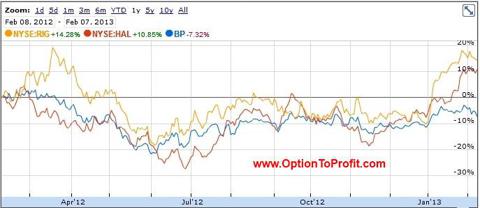
So when I received and then read his email early in the morning following a 200 point decline in the market the day before, most of which came in the final hour, I was already concerned about market direction, recent losses in the OTP portfolio and losses in my own portfolio.
To put a little perspective on the specific period of time, I had just written an article earlier in the week expressing concern that we were heading for a market drop similar to that seen in 2012. I reiterated that concern and the potential need to increase cash positions the next week in one of the Daily Market Updates.”
He was asking about his paper losses of the last two weeks. Those losses were well in excess of what I and the portfolio encountered, (not considering the 50 or so positions that have already been profitably closed in 2013.)
As it would turn out, after he graciously shared some information with me, approximately 30% of his portfolio was concentrated in 5 positions. Four of those were in “metals” and another in “energy.” What they had in common, much more importantly is that all had suffered large losses in recent weeks, even beyond what the market itself had suffered.
With that information it was easy to diagnose the problem. Diversification had been breached.
The very first blog I ever wrote was entitled “Diversification 101” back in 2007. It wasn’t really about a classic discussion of diversification, as I never seem to get involved in those, but it was an extension of the concept of portfolio diversification. Ultimately, it’s all about the management of risk and reducing risk exposure.
By its nature, the act of selling options is already an expression of desiring to manage risk, but it’s not sufficient.
Let’s get basic.
There are essentially 10 or 11 sectors, depending on who is doing the counting. I rarely invest in the Utility sector, but pretty much everything else is fair game.
In a diversified portfolio you would have each sector in which you invest represent an equivalent percentage in your portfolio. For example, if your portfolio currently invests in 7 sectors, each should approximately represent 14% of your total portfolio.In a week, you may be in 6 sectors, eight or still at 7 and the representative proportions change accordingly.
Obviously, the bigger the portfolio the easier it is to be diversified, but large portfolios can also get confusing and unwieldly. It can be easy to lose track of precisely what families of companies you own when you have 20 or more stock positions.
Diversification on the basis of “sector” is a good place to start, but there’s lots more that needs to be done. Within each sector, the component stocks should be reasonably well distributed, recognizing of course that prices do change and the allocations will likewise be altered. Three stocks in a sector? Each should represent approximately one-third for that sector.
Beyond that, there may be rules for individual stocks as well, that comprise the sector. For example, a stock that is particularly volatile may be more appropriately owned at less than what may be the proportionate level.
For example, if you own stocks in a particular sector that is comprised of 5 stocks, within that sector each stock would be expected to comprise 20% of that sector. However, a more risky stock, as is usually designated as “MOMENTUM” in OTP trading alerts may warrant only a 10% position, or even less, depending on one’s individual taste for risk.
That reduced position is further diluted in a portfolio that consists of mutiple sectors.
When it comes to assembling a portfolio that is likely to change with great frequency particular attention has to be placed on monitoring diversification. To start, very often stocks that are assigned are parts of out-performing sectors. They, and their sector mates may be inappropriate to immediately add back to the portfolio because of their inflated prices. As a result, new purchases may then be in other sectors, inflating their relative proportions in your portfolio.
Additionally, very often when shares have fallen in price there is reason to consider adding additional shares as a means to erode paper losses by selling in the money calls on the new lot of shares. But by making those stock purchases you are adding to that particular sector and must do so with an eye both on the sector’s contribution to your overall portfolio as well as the individual stock’s contribution to the sector. Sometimes you feel as if you should turn a blind eye to the need for diversification because the downbeaten or under-performing shares may seem to be such bargains.
For example, I am currently unwilling to add shares of INTC or PBR because they are at their limits for their relative roles in my portfolio based upon their absolute values. If I buy more of either, despite what appear to be very appealing prices, I willl simply own too much of their shares.
In the case of CLF I’m not likely to add shares based on how great of a role I want a speculative stock, such as it is, to play in my portfolio. My CLF shares may not be of the same value as those of INTC or PBR, but I own enough “MOMENTUM” shares across all sectors. Now, especially during an unforgiving market, is not the time to stock up on volatile stocks.
One shortcoming of the methodology that I use to report ROI for Option to Profit subscribers is that there is an underlying assumption that each position is equally weighted in the OTP portfolio. In my real life trading, that isn’t the case as I try to stay within the distribution guidelines based on sector and individual
stocks. In general, I spend less on initial purchases of speculative positions than I do for more “TRADITIONAL” positions.
What’s important is to resist the enticement of the premium. The risky positions will offer a greater ROI, but you can work backward to determine how many shares of such a position to purchase. For example, if you purchased 400 shares of MetLife, a “TRADITIONAL” stock and received a net premium of $0.35, how many shares of Cliffs Natural Resources would you have to buy to generate the same net $140 in option premiums?
To answer my own question, using today’s data as an example, a $13,880 purchase of MET would net, after assignment the same as a $5,200 purchase of CLF.
Remember, it’s not about “Greed,” but rather about protecting your portfolio and having it work for you and creating additional income streams.
Although Option to Profit can report sector distribution to track diversification efforts, doing so is fairly unhelpful. It is inadequate for the individual, whose portfolio may be weighted very differently.
As a general rule, each person should define for themselves, for example, what proportion of their portolio do they want invested in “MOMENTUM” stocks? Those are the kind with greater premiums, but come with greater volatility and, therefore risk.
After that, investors should keep an eye on their diversification by sector. It needn’t be precise, but you should have an overall idea, based on value of underlying shares, what kind of exposure you have to each sector. In a typical market, you’ll see under-performance in sectors on a rotating basis, which is made palatable by out-performance in other sectors. In time, the under-performers typically become out-performers, although individual stocks may lag.
The importance of having an idea of your general exposure is related to taking action on Trading Alerts.
If an alert is made for a stock in a particular sector in which you are already fully represented, or perhaps even overweight, then you would likely not want to consider taking the risk of over-exposure. Additionally, if the individual stock has a risk profile that is great, such as a “MOMENTUM” stock, you would want to consider whether within the particular sector you already have sufficient risk exposure.
Ultimately, there will be times that you wished you had been overweight in a particular stock or sector. Although I’m not a gratuitously betting person, I am willing to bet that more often than not, you’ll end up being glad you had your assets spread out and diffused the risk.
Diversification is one of those things that really works over the long term. If you want to stay in the game don’t test the odds.










